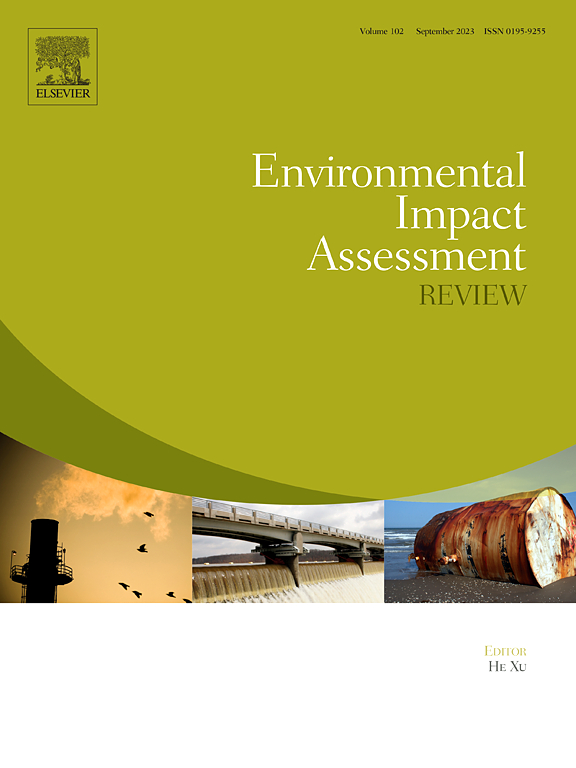Urban-rural disparities and future trends in dietary water footprint across African nations
IF 9.8
1区 社会学
Q1 ENVIRONMENTAL STUDIES
引用次数: 0
Abstract
This study investigates disparities in dietary water footprints (DWF) across Africa from a consumption-based perspective, focusing on urban-rural, inter-country, and food category dimensions. Using DWF data from 2010 to 2022 for urban and rural populations across 48 African countries and applying integrated assessment models, we analyze dietary consumption and DWF across 11 food types. The findings reveal significant structural differences in consumption patterns between urban and rural populations, across countries, and among dietary categories, as well as the current status and projected trends of DWF. Between 2010 and 2022, food consumption among urban residents in Africa increased by 10.3 %, while rural residents saw a decline of 5.4 %. Compared to urban residents, rural populations had higher grain intake but lower consumption of meat, fruits, and vegetables. The DWF for animal-based foods was notably higher than for plant-based foods, with beef showing the highest DWF at approximately 109.86 m3 in 2022, compared to fruits at 4.82 m3. Additionally, the analysis indicates notable inequalities in DWF among African countries, with widening disparities between the highest and lowest DWF-consuming countries, driven mainly by differences in poultry, beef, and grain consumption. Economic development also plays a key role, with higher-income countries experiencing greater increases in per capita DWF due to dietary shifts toward more water-intensive animal-based foods. The differences in DWF between urban and rural residents, as well as among countries, are projected to continue expanding. By 2030 and 2050, Africa's average DWF of African residents is expected to rise by 75.96 % and 534.51 %, respectively, relative to 2022. The DWF gap between the top and bottom five countries, recorded at 5026.13 m3 in 2022, is anticipated to increase to 7027.19 m3 by 2030 and 29,097.42 m3 by 2050. Scenario analysis shows that SSP3-RCP2.6, characterized by rapid population growth and resource-intensive diets, leads to the highest increase in DWF, while SSP1-RCP2.6, which assumes sustainable development and dietary shifts, results in the slowest growth. These findings support the potential for improving dietary structures in underserved areas by increasing access to nutrient-rich, plant-based foods, which may alleviate future water resource pressures.
非洲国家饮食水足迹的城乡差异和未来趋势
本研究从基于消费的角度调查了非洲各地饮食水足迹(DWF)的差异,重点关注城乡、国家间和食品类别维度。利用2010年至2022年48个非洲国家城乡人口DWF数据,并应用综合评估模型,我们分析了11种食物类型的饮食消费和DWF。研究结果揭示了城乡人口之间、不同国家之间、不同饮食类别之间的消费模式的重大结构性差异,以及DWF的现状和预测趋势。2010年至2022年期间,非洲城市居民的粮食消费增长了10.3%,而农村居民的粮食消费下降了5.4%。与城市居民相比,农村人口的粮食摄入量较高,但肉类、水果和蔬菜的消费量较低。动物性食品的DWF明显高于植物性食品,2022年牛肉的DWF最高,约为109.86立方米,而水果为4.82立方米。此外,分析还表明,非洲国家之间DWF存在明显的不平等,DWF最高消费国和最低消费国之间的差距不断扩大,这主要是由于家禽、牛肉和谷物消费的差异造成的。经济发展也起着关键作用,高收入国家的人均DWF增长幅度更大,原因是饮食转向更耗水的动物性食品。城乡居民之间以及国家之间的DWF差异预计将继续扩大。到2030年和2050年,非洲居民的平均DWF预计将分别比2022年增长75.96%和534.51%。2022年,前五名和后五名国家之间的DWF差距为5026.13立方米,预计到2030年将增加到7027.19立方米,到2050年将增加到29,097.42立方米。情景分析显示,以人口快速增长和资源密集型饮食为特征的SSP3-RCP2.6导致DWF增长最高,而以可持续发展和饮食转变为特征的SSP1-RCP2.6导致DWF增长最慢。这些发现支持通过增加获得营养丰富的植物性食物来改善服务不足地区饮食结构的潜力,这可能会减轻未来的水资源压力。
本文章由计算机程序翻译,如有差异,请以英文原文为准。
求助全文
约1分钟内获得全文
求助全文
来源期刊

Environmental Impact Assessment Review
ENVIRONMENTAL STUDIES-
CiteScore
12.60
自引率
10.10%
发文量
200
审稿时长
33 days
期刊介绍:
Environmental Impact Assessment Review is an interdisciplinary journal that serves a global audience of practitioners, policymakers, and academics involved in assessing the environmental impact of policies, projects, processes, and products. The journal focuses on innovative theory and practice in environmental impact assessment (EIA). Papers are expected to present innovative ideas, be topical, and coherent. The journal emphasizes concepts, methods, techniques, approaches, and systems related to EIA theory and practice.
 求助内容:
求助内容: 应助结果提醒方式:
应助结果提醒方式:


